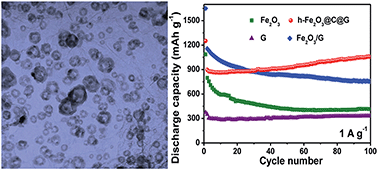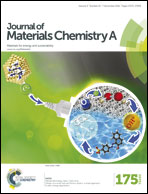Rational design of metal oxide hollow nanostructures decorated carbon nanosheets for superior lithium storage†
Abstract
Unique nanostructures and intimate interfaces in nanocomposites play great roles in enhancing performance for energy storage and conversion application. Though many studies have focused on graphene/metal oxide composites with weak interactions by physical loading or chemical anchoring, engineering of metal oxide hollow nanostructures (h-MO) and construction of strongly coupled interfaces between graphene and metal oxides still remain in their infancy. In this work, metal oxide hollow nanostructures were bound onto graphene nanosheets by graphitic carbon layers (the final hybrid is denoted as h-MO@C@G), which were confirmed by HRTEM observations. Polyvinylpyrrolidone (PVP) and its derived carbon play great roles in uniform loading and engineering of h-MO as well as intimate integration of MO with graphene nanosheets. Benefiting from the synergistic effects of MO hollow nanostructures and strongly coupled interfaces for structural robustness and enhanced lithiation kinetics, the resulting h-Fe2O3@C@G anodes exhibit long cycling life over 500 times and a high rate capacity of 430 mA h g−1 at 15 A g−1. More importantly, the strategy developed here can be easily extended to synthesize other single metal oxide (Co3O4, NiOx) or mixed metal oxide (FeNiOx) hollow nanostructures strongly coupled with graphene nanosheets, and they all exhibit excellent electrochemical performance.


 Please wait while we load your content...
Please wait while we load your content...